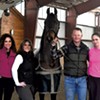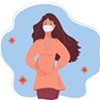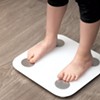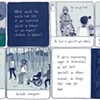Published August 27, 2019 at 10:00 a.m.
Normally, the human spine curves from front to back, forming an S-shaped curve when viewed from the side. However, in a small percentage of people, the spine curves to the left, right or both ways, forming a C or S shape when viewed head on. When that curvature is more than 10 degrees off midline, it's clinically defined as scoliosis.
Dr. Lewis First, chief of pediatrics at the University of Vermont Children's Hospital, offers the straight facts on scoliosis, including what causes it, how it's diagnosed and what can be done to treat it.
KIDS VT: How common is scoliosis?
LEWIS FIRST: About 1 to 3 percent of the population will have a curvature of the spine that is more than 10 degrees. For the vast majority of them, scoliosis is mild, painless and requires no intervention. We don't address it unless the curvature is at least 20 to 25 degrees. The prevalence of moderate scoliosis that would require bracing within the general population is 2 or 3 per 1,000 children, and severe scoliosis that would require surgery is 1 per 1,000 children.
KVT: What causes it?
LF: In children, there is congenital scoliosis and neuromuscular scoliosis. If it's congenital, usually you'll see the curve within the first two years of life, and that may be caused by the vertebrae not forming correctly in utero. If it's neuromuscular, it's caused by a disorder such as muscular dystrophy or cerebral palsy. However, most cases are idiopathic, meaning they have no known cause, but they tend to run in families. It's usually spotted during puberty and in periods of excessive growth spurts. That's when the spine tends to come out of line and starts to curve, for reasons we don't completely understand yet. It's important to note scoliosis is not caused by bad posture or by wearing heavy backpacks. The vast majority of cases are mild, and once puberty is over, the spine will likely not curve any farther.
KVT: Is it more common in girls or boys?
LF: With mild scoliosis, there's almost no difference by gender. But in cases of scoliosis above a 20-degree curvature, girls outnumber boys substantially — about one in 25 teen girls versus one in 200 teen boys. While the specific reason for the higher prevalence in girls is not clear, studies suggest that genetics, and hormonal and musculoskeletal differences between the sexes, play a role.
KVT: When and how do you screen kids for scoliosis?
LF: The American Academy of Pediatrics recommends looking for it during routine health maintenance exams beginning at age 10, or with the start of puberty, and continuing until puberty has ended. About 85 percent of all cases will occur between the ages of 10 and 14. In a doctor's office, we'll ask the child to bend over and touch their toes so we can observe the curvature of the spine. If there's a sideways curve, we have a device that can measure its angle. If it looks suspicious, we can follow it up with an X-ray to get a more precise measurement. If we see curvature of 10 degrees or more, we'll recommend monitoring it every six to 12 months to make sure the curvature isn't getting worse.
KVT: Do kids ever come in with complaints related to scoliosis?
LF: Most of the time it's asymptomatic. However, parents or caregivers may recognize signs of scoliosis in their kids, such as an unevenness of the shoulders when the child is standing up, or one shoulder blade that looks more prominent than the other. One hip may appear higher than the other, or one arm may appear to hang lower. It's only after a curvature of 20 to 25 degrees that kids start to complain of symptoms such as back pain. In severe cases, of 45 degrees or more, scoliosis can press the ribs into the lungs and create breathing problems.
KVT: Once scoliosis is identified, how is it treated?
LF: Early diagnosis is key because we can start treatment early and prevent the curve from worsening. When the curve is beyond 20 degrees, we recommend a brace, which is like a thick plastic jacket that fits around the abdomen, from underneath the arms and running down to the hips. Kids need to wear it 12 to 20 hours per day, and are supposed to wear it until the end of puberty. But only 20 to 30 percent of kids with scoliosis will need to wear a brace, and only 10 percent will require surgery.
The operation involves putting rods in to straighten the spine, then grafting pieces of bone between the spinal cord bones to insure that the spine no longer curves to the left or right. The good news is, the surgery tends to have very good outcomes. Six to 12 months later, kids can usually return to playing sports and doing everything else they could before the surgery. But like any surgery, there are always risks involved such as bleeding or post-operative infection.
KVT: Anything else?
LF: Anything that makes a teenager feel different from his or her peers can be difficult socially. So when you tell a teen that they need to wear their brace 20 hours per day, you can imagine what their compliance will be. We recommend that parents be supportive and understand that, for example, if a teenager is attending a dance or going to the beach with friends, it won't hurt them if they don't wear their brace for a few hours.
This article was originally published in Seven Days' monthly parenting magazine, Kids VT.
Speaking of...
-

How Can Parents Ease Kids' COVID-19 Anxieties About Returning to School?
Aug 24, 2021 -

How Can Parents Prevent and Treat Common Summertime Burns?
Jun 29, 2021 -

Should You Adjust Your Parenting Style to Your Child's Personality?
Jun 1, 2021 -

What Should Pregnant & Nursing Women Know About COVID-19?
May 4, 2021 -

Should Parents Be Concerned About Kids' Pandemic Weight Gain?
Apr 6, 2021 - More »
Comments
Comments are closed.
From 2014-2020, Seven Days allowed readers to comment on all stories posted on our website. While we've appreciated the suggestions and insights, right now Seven Days is prioritizing our core mission — producing high-quality, responsible local journalism — over moderating online debates between readers.
To criticize, correct or praise our reporting, please send us a letter to the editor or send us a tip. We’ll check it out and report the results.
Online comments may return when we have better tech tools for managing them. Thanks for reading.


















































